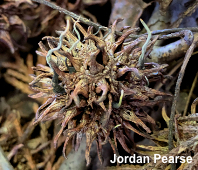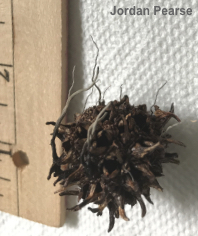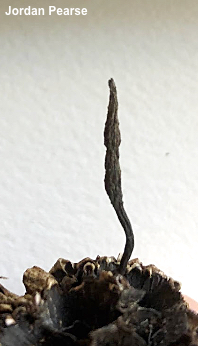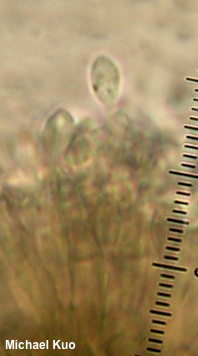| Major Groups > Clubs & Corals > Xylaria > Xylaria liquidambar |

|
Xylaria liquidambar [ Ascomycota > Sordariomycetes > Xylariales > Xylariaceae > Xylaria . . . ] by Michael Kuo Xylaria liquidambar would be macroscopically inseparable from several species of Xylaria if it weren't for the fact that it appears only on the decaying fruits of sweetgum trees—and nowhere else, apparently. The little mushrooms are narrowly cylindric, with pointed tips, and they can be difficult to distinguish from the spikes of the sweetgum fruit itself. In spring and early summer, Xylaria liquidambar has a pale gray, powdery covering (in this stage it is asexual, and the powdery covering consists of microscopic conidia). Later in summer the mushroom matures and its surface becomes black and minutely pimply (the little bumps are perithecia, filled with spore-producing machinery). "Xylaria liquidambaris" is the name applied by MycoBank and Index Fungorum, both of which appear to think that "liquidambar" constitutes bad Latin agreement. However the authors of the species argue: "The specific epithet was unnecessarily changed to 'liquidambaris' in Index of Fungi and MycoBank; 'liquidambar' is a noun legally used in apposition" (Ju et al. 2018). Sorting out who is right is above my high-school Latin pay grade, so I will side with the authors of the species because, well, just because. Thanks to Jordan Pearse for documenting, collecting, and preserving Xylaria liquidambar for study; her collection is deposited in The Herbarium of Michael Kuo. Description: Ecology: Saprobic on decaying fruits of sweetgum trees (Liquidambar styraciflua and Liquidambar formosana), growing gregariously, directly from the fruits; late spring through fall; In North America distributed from the lower Midwest and eastern United States through the southeastern United States and Mexico; also found in Asia. The illustrated and described collection is from South Carolina. Fruiting Body: 20–60 mm long; 1–3 mm thick; narrowly cylindric, with a pointy apex; only rarely branched; base black and often fuzzy; surface at first gray to pale gray and powdery, maturing to black, bald, and pimply; lacking a well-defined stem; interior flesh white and tough; perithecia in mature fruiting bodies more or less spherical, just below the surface. Odor: Not distinctive. Microscopic Features: Conidia 4–5 x 2.5–3 µm; fusiform-ellipsoid; smooth; hyaline in KOH. I have only examined immature fruiting bodies; mature spores are reported as 13–16 x 4–5.5 µm, subellipsoid, smooth, dark brown in water, with a single, spiraling germ slit; asci 8-spored. REFERENCES: J. D. Rogers, Y. M. Ju & F. San Martín, 2002. (Rogers et al., 2002; Rogers, Miller & Vasilyeva, 2008; Becerril-Navarrete et al., 2018; Ju et al., 2018.) Herb. Kuo 06152001, 09242001. This site contains no information about the edibility or toxicity of mushrooms. |
© MushroomExpert.Com |
|
Cite this page as: Kuo, M. (2020, July). Xylaria liquidambar. Retrieved from the MushroomExpert.Com Web site: http://www.mushroomexpert.com/xylaria_liquidambar.html |



